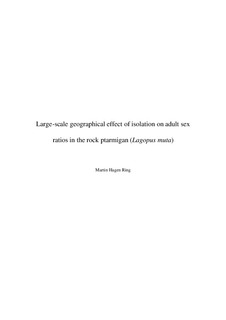Large-scale geographical effect of isolation on adult sex ratios in the rock ptarmigan (Lagopus muta)
Master thesis
Published version
Permanent lenke
http://hdl.handle.net/11250/2577627Utgivelsesdato
2018Metadata
Vis full innførselSamlinger
Sammendrag
Recent advances in sex ratio theory show that increased habitat isolation might be causing male-biased adult sex ratios (ASRs) in avian populations. This has raised concerns, since skewed ASRs are frequently seen in small and threatened populations. In this study we determined the ASRs of 20 isolated populations of the red-listed rock ptarmigan in southern Norway and Sweden, using non-invasive genetic sampling. The studied populations inhabit a fragmented mountain system that lay scattered around a large contiguous alpine landmass, which gives the montane landscape a mainland-island structure. The aim was to see if we could observe a pattern of male-skewed ASRs on the most isolated islands in this landscape. We calculated several estimates of isolation, including the islands distance from the mainland, stepping stone distances, and two isolation indexes that incorporate the isolation from other neighbouring islands. We found that an islands distance from the mainland alone correlated positively with male-biased ASRs, and that this correlation increased when stepping stone distances and the proximity to the other neighbouring islands were included when measuring isolation. We found no significant effect of area size of the focal island on skewed ASRs.
This is the first study that highlights the influence of isolation on ASRs on a large geographical scale, as previous studies have been based on local populations or on small geographical scales. Lastly, our findings might contribute to understanding the decline of rock ptarmigan populations observed in Europe over the last decades.
